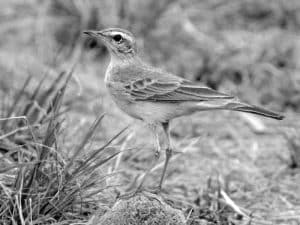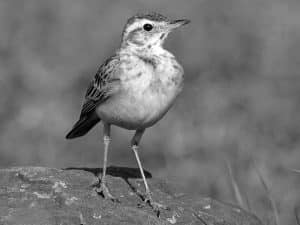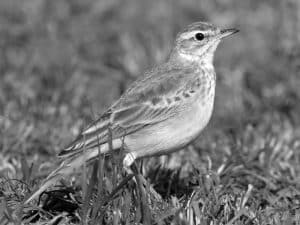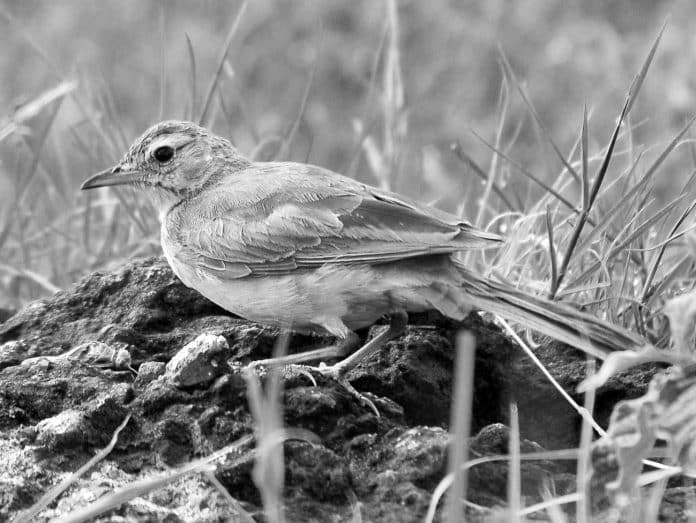Introduction to the plain-backed pipit
The plain-backed pipit, scientifically known as Anthus leucophrys, is a small, unassuming bird species that calls the diverse landscapes of Tanzania home. While it may not possess the vibrant plumage or striking features of some of its avian counterparts, the plain-backed pipit in Tanzania its understated elegance and unique adaptations make it a captivating subject for birdwatchers and nature enthusiasts alike.

In this comprehensive guide, we’ll delve into the fascinating world of the plain-backed pipit, exploring its physical characteristics, habitat preferences, breeding behaviors, and conservation status within Tanzania. Whether you’re a seasoned birder or simply curious about the natural wonders of this East African nation, this article will provide you with a deeper appreciation for this subtle yet remarkable species.
Physical characteristics of the plain-backed pipit
The plain-backed pipit is a small passerine bird, typically measuring between 14 to 16 centimeters (5.5 to 6.3 inches) in length and weighing around 18 to 25 grams (0.6 to 0.9 ounces). Its most distinguishing feature is the plain, unstreaked brown back that gives the species its name. The head is also a muted brown, with a faint supercilium (eyebrow-like stripe) and a subtle eye-ring.
The bird’s underparts are a pale buff or off-white color, with faint streaking on the breast and flanks. Its bill is slender and dark, while its legs and feet are a pale pinkish-brown hue. The plain-backed pipit’s wings are relatively long and pointed, allowing for efficient and agile flight as it forages across its preferred habitats.
One interesting characteristic of the plain-backed pipit is its ability to change the color and pattern of its plumage throughout the year. During the breeding season, the bird’s colors tend to be brighter and more vibrant, while in the non-breeding season, the plumage becomes more muted and subdued, helping the pipit blend seamlessly into its surroundings.
Habitat and distribution of the plain-backed pipit in Tanzania
The plain-backed pipit is widely distributed across Tanzania, inhabiting a diverse range of habitats throughout the country. Its preferred environments include:
- Grasslands and savannas: The plain-backed pipit thrives in open, grassy areas, often found in the vast, rolling savannas that cover much of Tanzania’s landscape.
- Cultivated fields and pastures: This adaptable species has also been known to inhabit human-modified landscapes, such as agricultural fields, orchards, and livestock grazing areas.
- Wetlands and marshes: While not its primary habitat, the plain-backed pipit can occasionally be spotted in wetland areas, such as marshes, swamps, and the fringes of lakes and rivers.
- Upland areas: In Tanzania, the plain-backed pipit can be found in highland regions, including montane grasslands and alpine meadows, particularly in the country’s southern and southwestern areas.
The species’ widespread distribution across Tanzania is a testament to its ability to thrive in a variety of environments, from the vast Serengeti plains to the rugged Kilimanjaro foothills. This adaptability has allowed the plain-backed pipit to establish a stable population throughout the country, making it a common sight for birdwatchers and nature enthusiasts exploring Tanzania’s diverse ecosystems.
Breeding behavior and lifecycle of the plain-backed pipit
The plain-backed pipit’s breeding behavior and lifecycle are closely tied to the seasonal changes in Tanzania’s climate. During the onset of the rainy season, typically between November and April, the birds engage in their annual mating and nesting rituals.
Courtship and Nest Building The male plain-backed pipit begins its courtship display by performing a series of song flights, soaring high into the air and then gliding back down to the ground, all the while emitting a distinctive, melodic call. This display serves to attract a potential mate and establish a breeding territory.
Once a pair has formed, they work together to construct a simple, cup-shaped nest, typically hidden in the base of a grass tussock or shrub. The nest is meticulously woven using a variety of materials, such as dry grass, moss, and animal hair, providing a cozy and well-camouflaged home for the upcoming clutch of eggs.
Egg Laying and Incubation The female plain-backed pipit will lay a clutch of 2 to 4 eggs, which she then incubates for a period of approximately 12 to 14 days. During this time, the male takes on the responsibility of providing food for his mate, ensuring she has the necessary energy to complete the incubation process.
Chick Rearing and Fledging Once the eggs hatch, both the male and female plain-backed pipits work tirelessly to feed and care for their hatchlings. The chicks, covered in sparse, downy feathers, are entirely dependent on their parents for the first few weeks of their lives. After approximately 12 to 15 days, the young pipits will fledge, or take their first tentative flights, and begin to venture out on their own.
Post-Breeding Dispersal Following the successful rearing of their offspring, the plain-backed pipits will often disperse from their breeding territories, with some individuals moving to different areas within Tanzania to take advantage of seasonal food sources and favorable conditions.
This intricate lifecycle, adapted to the rhythms of Tanzania’s climate, is a testament to the plain-backed pipit’s resilience and ability to thrive in its chosen habitat.
Diet and feeding habits of the plain-backed pipit
The plain-backed pipit is an opportunistic forager, utilizing a wide range of food sources to sustain itself throughout the year. Its diet primarily consists of:
- Insects and Arthropods: The plain-backed pipit is a skilled insect hunter, readily consuming a variety of beetles, grasshoppers, crickets, and spiders, which it locates by carefully scanning the ground and vegetation.
- Seeds and Grains: Depending on the season and availability, the plain-backed pipit will also supplement its diet with small seeds, grains, and other plant matter found in its grassland and agricultural habitats.
- Berries and Fruits: During the rainy season, when certain plant species are in fruit, the plain-backed pipit may occasionally forage for small berries and other edible fruits.
The bird’s foraging behavior is characterized by a distinctive hopping and walking gait, as it meticulously scours the ground and low-lying vegetation for its prey. When a suitable food item is spotted, the plain-backed pipit will pounce or lunge to capture it, often pausing to consume the morsel before resuming its search.
One fascinating aspect of the plain-backed pipit’s feeding habits is its ability to adapt to changes in food availability throughout the year. During the dry season, when insects and other invertebrates may be scarce, the bird will shift its focus to alternative food sources, such as seeds and grains, ensuring a steady supply of nourishment.
This adaptability, combined with its diverse dietary preferences, allows the plain-backed pipit to thrive in the varied habitats of Tanzania, making it a resilient and important component of the region’s delicate ecosystems.
Threats and conservation status of the plain-backed pipit in Tanzania
The plain-backed pipit is currently classified as a species of “Least Concern” by the International Union for Conservation of Nature (IUCN), indicating that its overall population is stable and not facing immediate threats of extinction. However, like many avian species, the plain-backed pipit does face a number of potential challenges that could impact its long-term survival in Tanzania.
Habitat Loss and Degradation One of the primary threats to the plain-backed pipit is the ongoing loss and degradation of its preferred grassland and savanna habitats. As Tanzania’s population grows and the demand for land for agriculture, urbanization, and infrastructure development increases, these natural ecosystems are being steadily converted or fragmented, leaving less suitable habitat for the pipit to thrive.
Pesticide and Pollution Exposure The use of pesticides and other agricultural chemicals in Tanzania’s cultivated fields and pastures can also pose a risk to the plain-backed pipit, as the bird may inadvertently ingest or come into contact with these harmful substances while foraging.
Climate Change and Extreme Weather Events The effects of climate change, including changes in rainfall patterns, temperature extremes, and the increased frequency of severe weather events, could also have a detrimental impact on the plain-backed pipit’s breeding success and overall population health.
Hunting and Trapping While not a significant threat at present, the occasional hunting or trapping of plain-backed pipits for the pet trade or traditional medicine practices could potentially impact local populations, particularly in areas with limited legal protections.
Despite these challenges, the plain-backed pipit remains a relatively common and widespread species throughout Tanzania, thanks in part to its adaptability and the ongoing conservation efforts of local authorities and environmental organizations. By raising awareness, promoting sustainable land-use practices, and implementing targeted conservation measures, the long-term future of this subtle yet remarkable bird can be safeguarded for generations to come.
Interesting facts about the plain-backed pipit
The plain-backed pipit may not be the most flashy or conspicuous bird species in Tanzania, but it possesses a number of fascinating traits and behaviors that make it a unique and captivating subject for birdwatchers and nature enthusiasts:
- Vocal Repertoire: In addition to its melodic courtship song, the plain-backed pipit has a repertoire of various calls and vocalizations, including a distinctive “seep” or “tseep” alarm call, used to alert other individuals to potential threats.
- Migratory Habits: While the majority of Tanzania’s plain-backed pipit population is resident, some individuals may undertake short-distance seasonal movements, traveling to different areas within the country in search of optimal feeding and breeding grounds.
- Dust Bathing: Like many other bird species, the plain-backed pipit engages in the behavior of “dust bathing,” which involves rolling and shuffling in dry soil or sand to help clean and maintain its feathers.
- Ground-Nesting Adaptations: The plain-backed pipit’s ground-nesting habits have led to the development of certain physical adaptations, such as its well-camouflaged plumage and the ability to run and hop quickly across the terrain to evade predators.
- Symbiotic Relationships: In some areas, the plain-backed pipit has been observed foraging in close association with larger grazing animals, such as wildebeests and zebras, taking advantage of the insects and invertebrates flushed up by the movements of these herbivores.
- Ecological Importance: As a prevalent member of Tanzania’s grassland and savanna ecosystems, the plain-backed pipit plays a crucial role in the local food web, serving as both a predator of insects and a prey item for larger avian and mammalian carnivores.
These and other fascinating facts about the plain-backed pipit serve to highlight the species’ unique place within Tanzania’s diverse avian community, and the important role it plays in the overall health and balance of the region’s natural environments.
Best locations for birdwatching the plain-backed pipit in Tanzania

Tanzania’s vast and varied landscapes offer ample opportunities for birdwatchers to spot the elusive yet captivating plain-backed pipit. Some of the best locations to observe this species include:
- Serengeti National Park: The expansive grasslands and savannas of the Serengeti are a prime habitat for the plain-backed pipit, with the species being a common sight throughout the park.
- Tarangire National Park: This park’s diverse ecosystems, including its iconic baobab-dotted landscapes, are home to thriving populations of the plain-backed pipit.
- Ngorongoro Conservation Area: The grassy slopes and highlands of the Ngorongoro Crater provide excellent vantage points for spotting the plain-backed pipit, as well as a host of other avian species.
- Arusha National Park: Located near the bustling city of Arusha, this park’s montane grasslands and wetland areas are a reliable destination for birdwatchers seeking the plain-backed pipit.
- Mikumi National Park: The open savannas and acacia woodlands of Mikumi National Park offer prime plain-backed pipit habitat, with the species being a common resident throughout the park.
When planning your birdwatching excursions in Tanzania, be sure to consult local guides, park rangers, or birding organizations to stay informed about the latest sightings and best practices for observing the plain-backed pipit and other elusive species.
Tips for observing and photographing the plain-backed pipit

Observing and capturing the plain-backed pipit on camera can be a rewarding yet challenging experience for birdwatchers and nature photographers. Here are some tips to help you make the most of your encounters with this subtle avian beauty:
- Patience and Stealth: The plain-backed pipit is a relatively shy and unobtrusive bird, so approach it slowly and quietly, avoiding sudden movements that could startle it away.
- Utilize Vantage Points: Scan the ground and low vegetation from elevated positions, such as hilltops or raised hides, to increase your chances of spotting the well-camouflaged pipit.
- Timing is Key: Early morning and late afternoon are often the best times to observe the plain-backed pipit, as it is most active during these periods when foraging for food.
- Blend In with the Environment: Wear muted, earth-toned clothing that helps you blend into the surrounding grasslands and savannas, minimizing the chances of the pipit detecting your presence.
- Use Appropriate Optics: Invest in a high-quality pair of binoculars or a telephoto lens to get a closer, more detailed view of the pipit’s intricate features and behaviors.
- Respect the Bird’s Space: Avoid getting too close to the plain-backed pipit, as this can stress the bird and disrupt its natural behavior. Maintain a respectful distance and use your optics to observe and photograph it.
- Be Patient and Persistent: It may take multiple visits and a keen eye to spot the plain-backed pipit, so be prepared to spend time in the field and persist in your search.
By following these tips and exercising patience and care, you’ll increase your chances of catching a glimpse of this elusive yet captivating species, and perhaps even capturing stunning photographs to commemorate your encounter.
Conclusion: Appreciating the beauty and importance of the plain-backed pipit
The plain-backed pipit may not be the most conspicuous or flashy bird species in Tanzania, but its understated elegance and unique adaptations make it a truly remarkable and valuable member of the region’s diverse avian community. From its well-camouflaged plumage and ground-nesting habits to its resilient and adaptable foraging strategies, the plain-backed pipit has evolved to thrive in the varied landscapes of this East African nation.
As birdwatchers and nature enthusiasts, it is our responsibility to appreciate and protect the plain-backed pipit, as well as the countless other species that call Tanzania home. By raising awareness, supporting conservation efforts, and practicing responsible and respectful observation, we can ensure that the plain-backed pipit and its kind continue to grace the skies and grasslands of Tanzania for generations to come.
To learn more about the plain-backed pipit and other fascinating birds found in Tanzania, consider joining a guided birdwatching tour or exploring the country’s diverse national parks and wildlife reserves. By immersing yourself in the natural wonders of this remarkable country, you’ll gain a deeper appreciation for the beauty and importance of its avian inhabitants, and contribute to their long-term conservation.

































